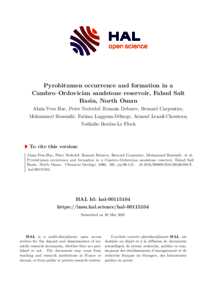وثيقة
Pyrobitumen occurrence and formation in a cambro-ordovician sandstone reservoir, Fahud salt Basin, North Oman.
المعرف
DOI: 10.1016/S0009-2541(00)00190-X
المصدر
Chemical Geology. v. 168, 1-2, p. 99-112
المساهمون
Nederlof, Peter., مؤلف
Debarre, Romain., مؤلف
Carpentier, Bernard., مؤلف
Boussafir, Mohammed., مؤلف
Laggoun-Défarge, Fatima., مؤلف
Lenail-Chouteau, Arnaud., مؤلف
الدولة
Netherlands.
مكان النشر
Amsterdam
الناشر
Elsevier Science B.V.
ميلادي
2000-07-01
اللغة
الأنجليزية
الموضوع
الملخص الإنجليزي
The Cambro-Ordovician Barik Sandstone reservoirs in the Fahud Salt Basin in Oman contain bitumen which may fill up to 40% of the porosity. In well Jaleel-1, this bitumen was isolated (according to kerogen procedure) and typed by NMR, elemental analysis and density measurements. The isolated bitumen is characterized by: (1) a highly aromatic character (NMR 75% C(Aro), H/C atomic ratio: 0.65), (2) a very high sulphur content (4.2%) and (3) a relatively high density (1.3-1.4 g/cm 3). The insolubility and the reflectivity of the bitumen (1.2% Vr) qualify it as a low mature pyrobitumen. The combination of Rock-Eval and density data was used to calculate the actual volume of the pyrobitumen in the rock, as a percentage of porosity. It was found that the pyrobitumen volume shows a negative correlation with total porosity, indicating that small pores are more invaded by bitumen than larger ones. Finally, closed system pyrolysis experiments, performed on oils with different NSO contents, indicate that an in situ oil with a very high content of NSO compounds is required to generate such large amounts of pyrobitumen in the pore system. These observations suggest that the precursor oil of the current pyrobitumen was a very heavy oil tentatively assumed to be the result of a severe biodegradation. Basin modeling shows that the reservoir was charged already in Devonian times. A major uplift brought the oil accumulation near the surface during the Carboniferous and a rather burial to the present day position (4500 m, 140°C) (Loosveld et al., 1996). This scenario, involving a residence time at shallow depth, strengthens the biodegradation hypothesis. The numerical modeling, which involves the IFP kinetic model for secondary oil cracking, suggests that pyrobitumen formation is a very recent event. Inclusion of pyrobitumen particles within quartz overgrowth, containing fluid inclusions, provides an upper temperature limit for the beginning of pyrobitumen formation which comforts the result of kinetic modelling.
ISSN
0009-2541
قالب العنصر
مقالات الدوريات

